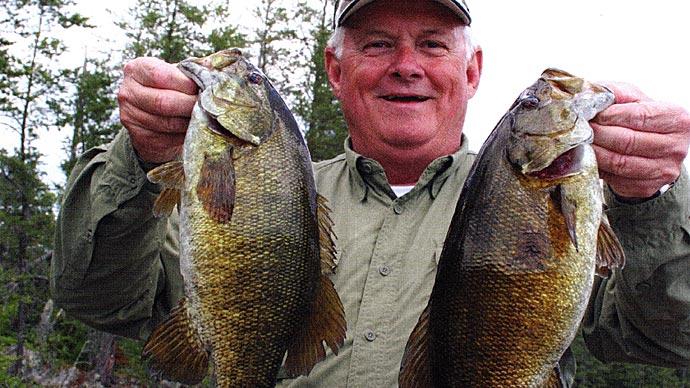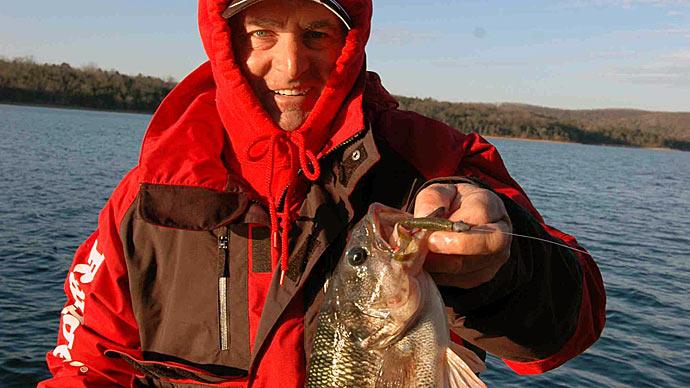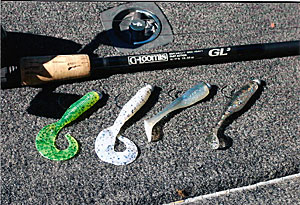
The first bass I caught in a tournament came on one. Soon after, I used this lure to catch enough bass to cash my first tournament check. Today, I still tie one on nearly every trip. What is this lure? It is the simple grub.
Grubs are one of the original soft plastic lures and continue to be a constant in an ever-changing tackle market. They rise to the forefront with an occasional big catch, but day-to-day, they are workhorses, filling a bass-producing role in many anglers’ tackle boxes. Their small profile and tail that quietly thumps whenever they are moved attract bass of all sizes. They can be rigged in many ways, which allows them to be fished anywhere.
The curly tail — also called a sickle tail — grub is the most popular with anglers. It has a chubby body and sometimes two tails, and nearly every soft-plastic lure manufacturer offers it. But it’s not the only style of grub. There also are shad or swim-tail models such as Mister Twister’s Sassy Shad. Originally classified as a grub, the swimbait crowd has adopted them. There also are spider and flat-tail grubs. And don’t count out smaller grubs, such as those used for panfish. In early spring, they catch just as many bass. All come in a rainbow of colors, from ones that precisely match the hatch to fluorescent ones that call bass from long distances.
Grubs work in many conditions. They are finesse enough to entice bass when bites are tough to trigger. When conditions are perfect and bass are biting, there is no easier meal than a grub falling next to where they are hiding. To get the most out of a grub, you must balance its rigging with where you want to fish it. Here’s how to make them work for you.
Rig it right
The most common way to rig a grub is on a lead-head jig. There are many styles of lead heads, and each imparts a different action on the attached grub. The ball head is an excellent all-around choice and the most popular. It shines when you hop a grub along the bottom or down a drop-off because its shape causes it to fall straight. When swimming a grub for suspended fish, use a darter head. Its conical nose points the grub in a different direction with each rod tip twitch. A flat-tail grub exaggerates its wandering action. Choose a football head when you want to slide a grub along the bottom. Its shape will keep the hook pointed up and add a crankbait-like wobbling action to the grub. As you pull it forward, the football head rolls off whatever it comes across, such as a rock or piece of wood. That extra shimmy makes a spider grub look even more like a crawdad.
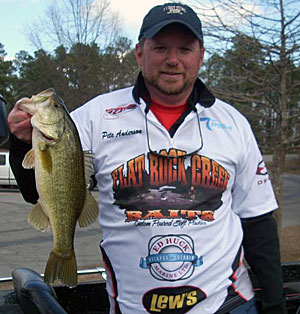
There is one style of lead head to stay away from with grubs: shakey heads. They are designed to keep a plastic worm in one spot while its tail shakes back and forth. That technique can load the boat, but a grub’s tail needs forward movement — whether that is up, down, or toward you— to work.
Choose a lead head with a light wire hook regardless of the style. But that doesn’t mean a small hook. Look for ones made with 2/0, 3/0, or 4/0 hooks. Choosing these larger sizes over the smaller ones many manufacturers use will increase the number of bass you hook. The orientation of the line tie can make a difference, too. Use flat eyes when pulling a grub and one parallel with the hook when hopping one.
Bassmaster Elite Series angler Justin Lucas goes a step further to get the perfect lead head, having his custom poured. That way, he can create ones for specific lures by adjusting the hook’s gap, size, and gauge of wire. If he’s throwing a 3-inch swim-tail grub on 10-pound test line, for example, he wants a head with a 2/0 hook. That size frees up the lure’s action and helps hook bass on long casts, which are the norm in clear water, where you typically fish that size lure. The Alabama pro paints his lead heads to match his soft-plastic lures, but he doesn’t touch his swim-tail heads. “Most baitfish have a silver flash, which plain lead mimics,” he said. “You’re saving money, too.”
Regardless of the style of lead head, rig the grub so its tail curves in the opposite direction of the hook bend. That keeps it in clean water, increasing its action at slow speeds and reducing the chance of sticking on the hook point and killing your presentation.
Grubs also are effective when Texas-rigged and fished in heavy cover such as grass or brush. The Slider-style heads, which feature a lead head molded to a worm-style hook, handle grubs well. Grubs will work on a traditional Texas rig, too. Thread a 5-inch grub, for example, on a 2/0 or 3/0 wide-gap hook. The extra space gives the grub a place to go when you set the hook, and the bend just below the line tie keeps the grub rigged. Use as light a weight as you can. For most casting situations, 1/16- or 1/8-ounce bullet sinkers will do the job. But as the cover becomes heavier, add as much weight as needed to penetrate it.
Grab the gear
Once your grub is rigged for the conditions, you must get it in the water. A 7-foot medium power, fast action spinning rod fishes grubs well from deep open water to shallow structure with some cover. The power refers to how much you can move with the rod, and the action is how the blank bends: A fast-action rod only loads in its tip, and a slow-action rod will bend to the handle. A crankbait rod is an example of a slow-action rod. A grub is a light-weight lure, so this style rod will cast it well. It’s also why you don’t want a heavy wire hook, which requires more force to be set. Your hook set will be more of a quick pull than an earth-shattering snap. The rod’s power and action will work together to keep the bass hooked. You’ll want to match this rod with a solid, front-drag spinning reel. Typically these reels have larger diameter drags, which are smoother than rear drags. A slightly larger model can help with line twist, as its larger spool doesn’t pack line in tight loops.
When cover starts to get thicker, you’ll need a casting rod. A 7-foot medium-heavy action rod with a high-speed reel will handle pitching grubs to grass and wood. You also can step up to a flipping stick if needed.
When using a spinning rod, 8-pound test will handle most of the work, though switch to 6-pound test if the water is super clear. Try 12- or 14-pound test when using a casting rod. When flipping grubs around wood and heavy grass on tidal water, it’s not uncommon to use 20- or 25-pound test. Monofilament is my primary choice. Its stretch helps keep bass hooked. If you are fishing deep water, fluorocarbon brings more sensitivity and sinks, helping to get your grub down. Braid is an excellent option in cold water, when bites are light, or in heavy grass, which slices through vegetation instead of collecting it. You may want to compensate for braid’s lack of stretch by using a slightly lighter action rod.
Fish it right
Like a spinnerbait or jig, a grub is a very versatile lure. You can fish it shallow or deep through open water or in the lake's heaviest piece of cover. But there are a few situations where it works best. Here are some of those places.
The first place is around rocks. Finding a depth change is critical, whether a drop-off or hump. Rig it on a round lead head to keep it falling along the depth change. If bass are active, you can swim them past the rocks.
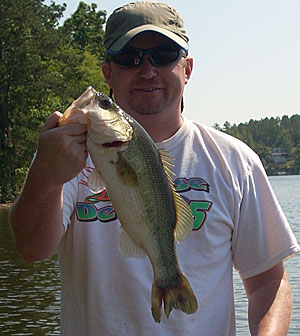
The next place is in scattered grass and rock. If it’s more rock than weeds, rig it on the lead head. Use a Texas rig if the situation is reversed. You’ll want to pull it up and let it flutter into the holes or next to weed clumps. In this situation, a spider grub rigged on a football head can be tough to beat. Just cast it out and drag it along the bottom. Aim it toward any piece of wood, large rock, or weed edge that bass could use as an ambush point.
Large submerged grass beds also are great spots for grubs. Here you’ll want to use a casting rod and a Texas-rigged grub with a 3/16- or ¼-ounce weight. Pitch it to the holes in the grass, or if it is deep enough, just swim it through the top of the grass or just over it.
Grubs are well suited to tidal water, where bass, for the most part, seem to prefer more compact lures. The bass that live in these estuaries rely on structure and cover to shield them from moving water. Texas rig your grub so that it won’t get snagged. Flip it like a jig, right into the heaviest cover. Use enough weight to overcome any current and strong enough line to pull a bass out of the heavy cover.
If you see schools of bass relating to shad in deep water, you can drop a grub down and catch them. Unlike a jig, tube, or even a spoon, you want to give your grub as much time on the fall as possible because that’s when it takes the most action. So add more height to your hops. Don’t be afraid to lift your rod above your head. As you follow the grub back down, keep the line semi-tight. You don’t want the line to be so tight it affects the fall, but you also don’t want so much slack in the line that you miss a bite.
Swim-tail grubs, such as the Sassy Shad or Keitech Swinging Impact, can be an excellent substitute for a spinnerbait, especially in clear water. That’s what happened at the 2015 Bassmaster Classic on Lake Hartwell. Many of the competitors were catching key fish each day around shallow rock, wood, and docks with this style of grub that was rigged on a ball head or shad-shaped lead head. Just as they would with a spinnerbait or square-bill crankbait, they slow-rolled the grub past ambush spots. Some were using the same grub, with a little heavier head, on deep schools.
That type of versatility adds to the fish-catching worth of the grub. Does that make this the perfect lure? No, there is not one perfect lure. However, by rigging grubs in different ways and fishing in different situations, grubs come close enough to earn a permanent spot in your tackle box.


